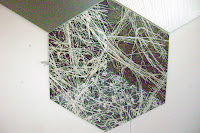
A request for free product for
the purposes of creating artwork was well received by Wattyl wholesaler suppliers. The product, Pearl Essence, is in slow decline with some niche uses emerging. The sponsor is keen to explore its creative potential. The agreement provides 4 litres of base paint each quarter, and a trade outlet has agreed to supply tints to my specification. Artwork from my stock can be supplied for their use while waiting for exhibitions. Great interest was shown in my current project
Compound I, and its deeper themes grasped surprisingly quickly. the very compound nature of the products provides an ideal showcase for the product which may enjoy a new relevance in creative spheres. A good blend of commercial and artistic imperatives.
Learning: This was an exercise in quick lateral thinking, the challenge being how to get a maximum range of colours from 4 litres, in meaningful amounts in a way that doesn't hinder the staff accustomed to selling in bulk. 8 base colours were chosen,
which can be re tinted lighter and darker with black and white tint effectively giving me 24 tints to play with.
 Preparation for substrarte addition.
Preparation for substrarte addition. Feeling the theme was getting lost in 'surface' layers of creation, I feel the need to reassert the emphasis on cosmic substrate and to keep the surfaces in context. This mega-molecule arrangement is informed by incomplete NASA type photo-surveys of other planets as well as by subatomic and molecular structures. This also deviates away from the block arrangement we are accustomed to with traditional tessellated tile arrangements. The 3 D tones will be achieved with the tinted matt, gloss and satin technique.
Feeling the theme was getting lost in 'surface' layers of creation, I feel the need to reassert the emphasis on cosmic substrate and to keep the surfaces in context. This mega-molecule arrangement is informed by incomplete NASA type photo-surveys of other planets as well as by subatomic and molecular structures. This also deviates away from the block arrangement we are accustomed to with traditional tessellated tile arrangements. The 3 D tones will be achieved with the tinted matt, gloss and satin technique.

























